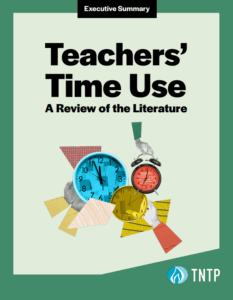This Teacher Appreciation Month, we’re reflecting on what it would look like if, in addition to the usual tokens of appreciation given to teachers in May, we ensured teachers feel valued and celebrated every day of the year. Here are five ways education leaders and policymakers can help to bring more flexibility, sustainability, and joy to the role of teaching:
- Listen to teachers. Understanding teachers’ experiences, aspirations, assets, and preferences will provide key input you can use to make the improvements teachers really want. One way to gather input is through TNTP’s Insight survey, which provides concrete feedback on the aspects of school culture that matter most for teacher and student success. Gathering feedback could also just be a quick and easy 30-second “pulse check.” It’s particularly important to learn about the experiences of teachers of color, and to use their feedback to provide better, more supportive environments. Regularly tapping into teacher voice can help leaders gain actionable information that can help to increase teacher retention and improve student learning.
- Protect teachers’ time. When school leaders create sustainable workloads that allow teachers to take care of themselves, they can show up at their best for students. Look at your teachers’ schedules and eliminate what doesn’t help them deliver high–quality instruction and social-emotional learning. Get rid of bad professional development sit-and-gets and limit non-instructional tasks as well as other time and energy wasters that make teaching unsustainable. Instead, provide sufficient time for instructional planning, practice, and collaboration—and invite educators to participate in high-quality professional learning sessions that provide practical resources and strategies that can be used immediately.
- Rethink teacher staffing and scheduling models. It’s time to explore ways to reimagine the model of one teacher in front of 30 students. Review the assets and goals your educators have and create opportunities that set them up to lean into their strengths and have meaningful professional experiences. We know that significant challenges persist when it comes to staffing coming out of the pandemic. Our guide, Addressing Teacher Shortages, provides strategies to rethink staffing and scheduling models, as well as guidance on short-term priorities like covering absences and filling vacancies.
- Put a spotlight on great teaching. Elevate stories and examples of great teaching and their impact on students within and beyond your school community. Record short videos of your teachers modeling best practices and share them in staff emails or faculty meetings. Or reach out to local media to let them know about teacher successes, so that the broader community can see and celebrate the great work that’s happening in your school.
- Pay teachers more and reward performance. It’s simple: every teacher deserves a professional-level salary from the start of their careers. In addition to paying teachers more, those who have a positive influence on student learning deserve greater compensation. And antiquated salary schedules that narrowly reward just tenure or credentials, and leave out performance, stand in the way of a high-quality teacher workforce. Additionally, as districts across the country continue efforts to diversify their teaching staff, a better paycheck could help to make teaching a more viable and long-term career for candidates of color, especially when paired with mentoring and other support during their first years in the classroom.
Let’s recommit to showing teachers how much we value them by providing them with the gifts they deserve: recognition and compensation, professional growth opportunities, and sustainable working conditions.








